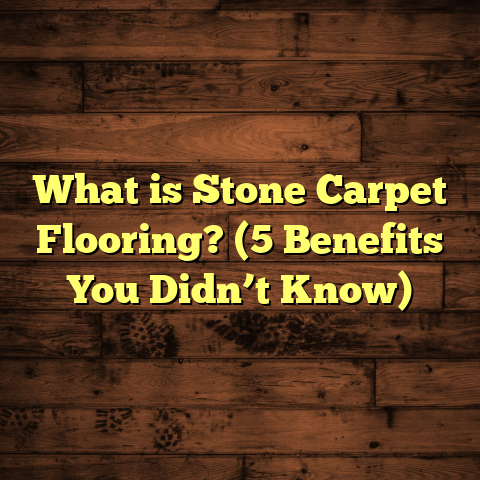What is Mil Rating for Vinyl Flooring? (5 Key Benefits Explained)
Would you rather have a vinyl floor that looks fresh and flawless for over a decade or one that starts showing scratches, dents, and stains within just a couple of years? If you’re in the market for vinyl flooring, you’ve probably bumped into the term mil rating more than once. But what does it actually mean? And why should you care about it? I’ve been working hands-on with flooring for years, and understanding mil rating isn’t just jargon—it’s key to picking the right vinyl floor that fits your lifestyle and budget.
What is Mil Rating for Vinyl Flooring?
Let’s break it down simply. The word “mil” in flooring is a unit of thickness—a thousandth of an inch (0.001 inch). When we talk about the mil rating of vinyl flooring, we’re specifically referring to the thickness of the wear layer—the top protective layer that takes all the abuse from foot traffic, spills, scratches, and more.
Think about it—your vinyl floor’s wear layer is the shield guarding the design and structure underneath. The thicker this layer is, the better it can resist damage. Mil ratings usually range from 6 mil (very thin) to 20 mil or even higher for commercial-grade flooring.
When I first started in this business, I didn’t fully appreciate how much difference the wear layer’s thickness made. A client went with a low mil rating floor to save money, and within a year, the surface was scuffed and peeling. I convinced them to upgrade next time, and their new 20 mil floor lasted over 10 years without a hiccup. That experience stuck with me.
The Build of a Vinyl Floor
Before we go deeper, it helps to understand how vinyl flooring is structured:
- Wear Layer: Transparent protective layer measured in mils.
- Print Layer: The decorative design that gives vinyl its look.
- Core Layer: The main body providing strength and stability.
- Backing Layer: The bottom layer that adds support and sometimes moisture resistance.
The wear layer is your first line of defense against wear and tear. It’s what determines longevity and performance more than anything else.
Why Thickness Matters
Imagine wearing a thin coat of paint on your walls—it might look okay initially but will chip easily. Now think about a thick premium paint that can take scrubs and bumps. That’s what the wear layer thickness does for vinyl floors.
Here’s a quick rundown based on years of working with clients and industry data:
| Mil Rating | Best Use Case | Expected Wear Life |
|---|---|---|
| 6-8 mil | Low traffic residential areas | 3-5 years |
| 12-15 mil | Medium traffic residential areas | 7-10 years |
| 20+ mil | Commercial/High traffic areas | 12+ years |
How I Learned to Value Mil Rating
Early in my career, I handled a project for a small café. They wanted to install vinyl floors but were sensitive about costs. We went with a 6 mil wear layer option to stay within budget. Fast forward 18 months—the floor was scratched, stained, and showing serious wear. The café owner was unhappy because they had to close early one day to replace parts of the floor.
After that, I started recommending thicker wear layers more strongly, especially for high-traffic or commercial settings. For another client renovating a busy veterinary clinic, we chose 20 mil wear layer vinyl. Even after four years of constant foot traffic and occasional pet accidents, the floor looked almost brand new.
Five Key Benefits of Understanding Mil Rating for Vinyl Flooring
1. Durability Tailored to Your Lifestyle
One of the biggest mistakes I see is people choosing vinyl floors based solely on price or appearance without considering wear layer thickness. You don’t want to pick a 6 mil wear layer if you have kids running around or pets scratching surfaces daily—trust me.
Ask yourself: How much traffic will this floor get? Will it need to handle furniture moving or heavy appliances? If you live alone in a quiet apartment where you rarely host guests, thinner wear layers might work fine. But for busy families or commercial spaces, thicker is always better.
I helped a family with two young kids pick out vinyl flooring for their kitchen and playroom. We settled on 15 mil wear layer vinyl because it was thick enough to survive spills, toys dropped on the floor, and frequent cleaning but wasn’t overkill on cost.
2. Saving Money Over Time
It’s tempting to choose the cheapest floor upfront, but here’s the catch: cheaper floors with thinner wear layers often mean having to replace them sooner. This adds up when factoring in installation fees, downtime, and hassle.
In my experience, clients who pick thicker wear layers end up saving money over five to ten years because their floors don’t need early replacement or repairs. One restaurant owner who invested in 20 mil commercial vinyl told me he avoided thousands in replacement costs after five years of heavy kitchen use.
3. Better Resistance to Scratches and Stains
A thicker wear layer means better protection against everyday accidents—scratches from pets’ nails, dents from dropped utensils, stains from wine spills—you name it.
I remember installing vinyl with a 12 mil wear layer in a family home with two dogs. Even after months of pets running around and muddy paws, the floor barely showed signs of damage compared to other homes with thinner wear layers.
4. Improved Appearance and Feel
Vinyl flooring isn’t just about durability; it also looks good underfoot. Thicker wear layers usually come with enhanced surface textures that give floors a more natural look and reduce slipperiness.
For example, upgrading from an 8 mil to a 15 mil wear layer in one renovation project gave the floor a subtle embossed texture resembling wood grain. This not only improved safety but also made the space feel warmer and cozier.
5. Easier Maintenance and Long-Term Care
Thicker wear layers can handle stronger cleaning methods without wearing down prematurely. That means you can mop aggressively or even use steam cleaners occasionally without damaging the surface.
I worked with a commercial gym that needed daily cleaning using industrial equipment. Choosing vinyl with a robust 20 mil wear layer meant their floors stayed intact despite heavy maintenance routines.
Breaking Down Mil Ratings: What Does Each Number Really Mean?
Let’s take a closer look at common mil ratings you’ll find on vinyl floors.
6 to 8 Mil Wear Layer – Budget-Friendly but Limited
This range is typically found in entry-level residential vinyl flooring. It offers basic scratch resistance but wears down quickly in high-traffic areas.
I recommend this only for:
- Guest rooms
- Closets
- Areas with minimal foot traffic
If you want something quick and cheap for low-use spaces, this is fine—but expect to replace it in 3-5 years.
10 to 15 Mil Wear Layer – Balanced Performance
This mid-range is perfect for most residential homes with average traffic levels. It offers decent scratch resistance and better durability than thinner options.
Families with kids or pets generally find this range meets their needs without breaking the bank.
In my experience helping families remodel kitchens or living rooms, this range hits the sweet spot between price and performance.
20+ Mil Wear Layer – Commercial Grade Toughness
Anything at or above 20 mil is designed for commercial use or very high-traffic homes. These floors stand up well to heavy furniture movement, spills, scratches, and industrial cleaning products.
I worked on several restaurant projects where only 20+ mil wear layers passed health inspections due to durability requirements.
These floors often come with specialized coatings like aluminum oxide or ceramic bead infusions for extra protection.
Materials Behind the Wear Layer: What Makes It Strong?
Thickness isn’t everything—what the wear layer is made of matters too. Here are some common materials used:
- Urethane: A tough polymer that resists scratches and stains.
- Aluminum Oxide: A super-hard coating commonly used in hardwood floors but also added to premium vinyl for extra protection.
- Ceramic Beads: Tiny particles embedded into the wear layer that increase scratch resistance.
- UV-Cured Coatings: Hardened with ultraviolet light during manufacturing for better durability.
When I advise clients on premium vinyl options, I always look beyond mils to see what protective materials are included because that can affect performance dramatically.
How Thickness Affects Installation Choices
You might wonder if thicker wear layers change how floors are installed or maintained. Here’s what I’ve learned:
- Thicker wear layers don’t usually mean harder installation, but some luxury vinyl planks (LVP) with thick layers come as rigid core boards needing specific underlays.
- Cleaning recommendations can vary based on wear layer toughness—thicker layers allow more aggressive cleaning.
- For DIYers, thicker wear layers mean less worry about scratching during installation, which is handy if you’re new to laying floors.
Cost Breakdown: How Mil Rating Impacts Your Budget
Pricing vinyl flooring depends on several factors including material quality, brand, size, and yes—the mil rating.
Here’s an example based on recent projects:
| Wear Layer Thickness | Cost per Sq Ft (Material Only) | Typical Installation Cost per Sq Ft | Total Estimated Cost per Sq Ft |
|---|---|---|---|
| 6-8 mil | $1.50 – $2 | $1 – $2 | $2.50 – $4 |
| 12-15 mil | $2 – $3 | $1 – $2 | $3 – $5 |
| 20+ mil | $3 – $5 | $1.50 – $3 | $4.50 – $8 |
When I’m budgeting projects these days, I rely heavily on tools like FloorTally to nail down accurate estimates quickly. It helps me input local labor rates, material choices including mil ratings, and even factors in waste percentages.
FloorTally simplifies juggling costs so I can present clear options to clients without overwhelming them with numbers or guesswork.
My Personal Experience Using FloorTally for Vinyl Projects
I remember working on a large condo renovation recently—multiple units needed new vinyl floors with different traffic needs. Instead of guessing square footage or costs manually, FloorTally let me:
- Enter room dimensions quickly
- Select wear layer thicknesses for each unit
- Factor in local labor prices easily
- Generate side-by-side cost comparisons for clients
This saved hours of back-and-forth quoting and helped clients make confident decisions aligned with their budgets and needs.
FAQs About Mil Rating You Might Have
Does thicker always mean better?
Usually yes for durability, but you should balance thickness with your budget and usage needs. Sometimes mid-range thickness paired with good coatings works fine for moderate traffic.
Can I add an extra wear layer after installation?
Nope. The wear layer is factory-applied during manufacturing, so what you buy is what you get.
How do I know what mil rating my vinyl floor has?
Manufacturers typically list this on packaging or product specs online. If unsure, ask your flooring supplier directly—they should provide this info upfront.
What happens if my floor has too thin a wear layer?
It’ll show scratches faster, stain more easily, and probably need replacement sooner than thicker options.
Are there any warranties tied to mil ratings?
Yes! Many manufacturers offer longer warranties for floors with thicker wear layers (e.g., 10+ years warranty on 12+ mil floors).
Real-Life Case Study: Flooring for Busy Family Homes vs Commercial Spaces
Let me share two contrasting examples from my work:
- Busy Family Home: A household with four kids and two dogs required durable yet stylish flooring in kitchens and play areas. We chose vinyl with a 15 mil wear layer plus ceramic bead coating for extra scratch resistance. After three years of heavy use, minimal visible damage was reported.
- Commercial Office Space: This office saw hundreds of visitors daily including staff moving furniture regularly. We selected commercial-grade vinyl with a 20 mil wear layer reinforced by aluminum oxide coating. After five years, their floor still looked pristine despite heavy foot traffic.
Both projects highlight how choosing appropriate mil ratings based on use cases ensures satisfaction over time—and fewer headaches down the road.
Maintenance Tips Based on Wear Layer Thickness
Knowing your floor’s wear layer helps guide maintenance:
- For floors under 10 mil: Use gentle cleaning solutions & soft mops only.
- Floors between 10-15 mil: Regular vacuuming & damp mopping works well; avoid harsh chemicals.
- Floors above 15 mil: Safe for stronger cleaners; occasional deep cleaning possible without damage.
I always advise clients to avoid abrasive scrubbing pads regardless of thickness because those can damage any surface eventually.
Environmental Impact & Longevity
Choosing thicker wear layers also plays into sustainability because:
- Longer-lasting floors mean fewer replacements = less waste.
- Some high-quality wear layers include recycled materials or are recyclable themselves.
I worked with an eco-conscious client who prioritized durability combined with recycled content in their vinyl selection—a win-win for performance and green living.
Trends in Vinyl Flooring Wear Layers
Over the past decade, I’ve noticed:
- An increase in demand for floors with 12+ mil ratings as homeowners want both durability & style.
- More manufacturers adding advanced coatings like ceramic beads for scratch resistance.
- Growing popularity of rigid core luxury vinyl planks (LVP) combining thick wear layers with dimensional stability.
These trends reflect a market moving toward longer-lasting products that suit both residential comfort and commercial toughness.
Can You DIY Install High-Mil Vinyl Flooring?
Yes! Many high-mil luxury vinyl planks come with click-lock systems designed for DIY installation. However:
- Heavier boards may require more effort handling.
- Proper subfloor prep is still crucial regardless of thickness.
From experience helping friends install their own floors at home—with thick wear layer LVP—the key is patience and following manufacturer instructions carefully.
Final Thoughts on Choosing Your Vinyl Floor’s Mil Rating
After all these years working hands-on with clients across different settings, I can confidently say that understanding mil rating is one of the smartest moves when selecting vinyl flooring.
It’s not just about thickness—it’s about matching durability to lifestyle demands so your floors keep looking great longer without surprise costs or hassle.
For anyone wondering how much they should invest upfront versus risk earlier replacement later—think about your daily foot traffic patterns honestly and pick accordingly.
And if crunching numbers feels overwhelming like it once did for me, tools like FloorTally make cost estimation straightforward and transparent—helping avoid budget surprises while choosing exactly what you need.
So next time you’re shopping or planning your project, ask yourself: How thick does my floor need to be? This simple question can save you headaches—and money—for years down the line.





